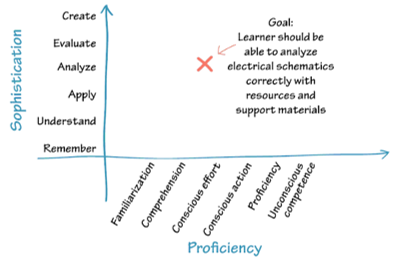Learning objectives
These notes are part of a series for the book.
Outline
- Determine goals
- Identify the problem
- Set the destination
- Communicate learning objectives
- Determine the gap
- How long is the trip?
- Summary
Notes
Start with the gap
Before identifying the goals and learning objectives, identify the gaps that the training is supposed to bridge. ‘A lot of learning projects start with the goal, rather than the problem, but that puts you in the position of solving problems you don’t actually have, while failing to address the real issues’ (Dirksen, 2012, p. 60). Find out:
- What will happen if the learners don’t learn the new knowledge, skills, or attitudes? How are they going to use it if they do?
- At the root of it all, why is it important to know?
Next, define the learning objectives
Learning objectives should be measurable, so saying that the learner will “understand” something by the end of the course is too vague. Sometimes people work around this by using other verbs like “will be able to explain” or “will be able to define”, and this is also problematic because what you really want the learner to be able to do is not define or explain, but to apply the new skills to their job. That is, in the real world most of us are not asked to define or describe things as part of their work. Dirksen (2012) recommends asking these two questions about each of your learning objectives:
- Would the learner really do this in their job?
- Can I tell when they’ve done it?
Then establish a level of learning or proficiency
Do one of these:
- Use Bloom’s Taxonomy (remember, understand, apply, analyze, evaluate create) to specify the level of learning for each objective.
- Specify how proficient the learner should be in each objective by using a scale such as the one proposed by Gloria Gery (1991), which has these levels: familiarization, comprehension, conscious effort, conscious action, proficiency, and unconscious competence.
- Do both! Dirksen proposes setting the two taxonomies on X and Y axes, and then marking where on the grid the learning objective belongs. Here’s what that looks like in her example:

(Dirksen, 2012, p. 70)
Write the objectives in ways that are appropriate for the people using them
You may need to share a learning objective with different audiences, who will use it for different reasons. (Dirksen draws on Will Thalheimer’s taxonomy in this discussion.)
- The course designer needs it to guide the course design and development.
- The person evaluating the course needs it to help them evaluate the instruction (and level of instruction) in the course.
- The learner needs it to help them know what to focus on, and to help them understand the level of proficiency required of them after the course.
It’s not easy to write one learning objective that meets the needs of all three groups, so you may need to write the same objective in multiple ways to help each group.
Now, return to the gap
With the learning objectives defined, it’s time to focus back on the performance gap to identify their causes. What’s holding the learners back and preventing them from already performing at the desired level?
- Knowledge
- Skills
- Motivation or attitude
- Environment: They are prevented from doing the right thing because of a roadblock, process, not enough time, or not enough support
- Communication or leadership: They are given vague, conflicting, or incorrect information
This helps you pinpoint whether or not the gap can be narrowed with training, and also helps you uncover how long it may take for the gap to be narrowed. In general, gaps involving knowledge (specific facts and how to use specific tools) can be addressed more quickly than skills and attitudes. Slower still are what Dirksen calls “foundation”: cultural, core values, and personality traits.
The goal of a course may include a mixture of learning objectives that are fast, medium, and slow to address. It makes sense to realize that you will not be able to really change the foundation, so anything you put in place must fit the learners’ existing culture, values, and personality traits. Design tips:
- Knowledge gaps that are fast to address: Provide tools, checklists, procedures
- Skills and some motivation gaps that are moderately fast to address: Provide practice scenarios and role-plays in spaced intervals with feedback at the end of each interval
- Strategic and high-level skills and some attitude gaps that are slow to address: Provide coaching, extensive practice, additional resources for study, and help defining personal development goals
- Foundation gaps: While you are unlikely to be able to change these, you can help learners become aware of gaps in these areas by providing self-assessment tools that show the effects of these gaps on their work or in their context